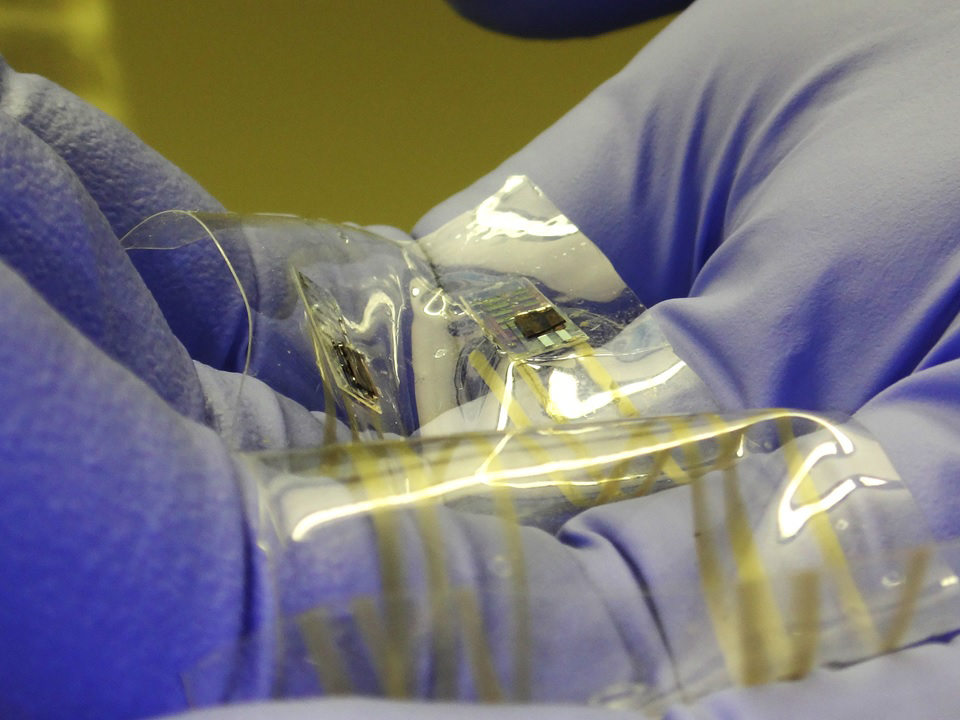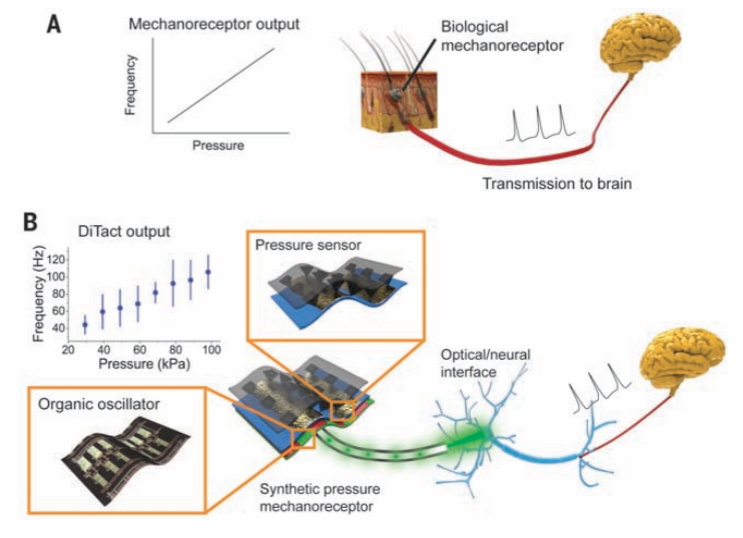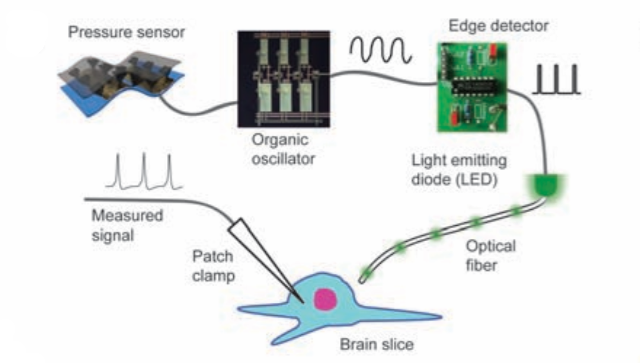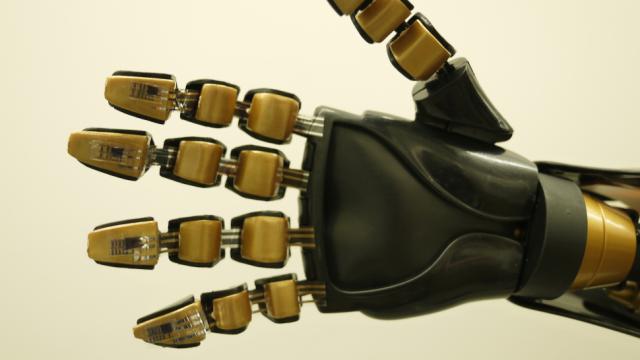Cutting-edge prosthesis are amazing, but they lack one very important feature: a sense of touch. Now a research team from Stanford University has developed artificial skin that can sense force exerted by objects — and then transmit those sensory signals to brain cells.
Inadequate sensory feedback is a serious limitation of current prosthetic limbs, whether they be artificial hands, arms, or legs. Users need to be able to sense how an object is responding to their touch in order to have optimal motor control. Otherwise, it’s difficult to know how much force is being exerted on an object, or sense things like temperature and texture. What’s more, the sense of touch — or even the illusion of it — can alleviate phantom limb pain, which affects some 80% of amputees.
We’re still a long ways off from being able to create artificial skin that feels and reacts the same way that natural skin does, but the Stanford team, led by electrical engineer Benjamin Tee, recently performed a proof-of-concept experiment that takes us a considerable step closer.

Stretchable skin with flexible artificial mechanoreceptors (Credit: Bao Research Group/Stanford University
By using flexible organic circuits and an innovative new pressure sensor, Tee’s team developed a kind of artificial skin that can sense the force of static objects. What’s more, this sensory data was then transmitted to cultured, i.e. in vitro, brain cells of mice using optogenetic technology. They have published the results of their work in the journal Science.
Tiny Pyramids of Touch
The system, called DiTact (Digital Tactile System), is based on a low-power, flexible organic transistor circuit that transforms the feeling of pressure into the same kind of signals generated naturally by natural skin’s mechanoreceptors. These signals were in turn converted to a series of voltage pulses.

The DiTact System (Credit: Tee et al., 2015/Science)
To get the sensors to record the wide dynamic range of pressure, the researchers used carbon nanotubes moulded into pyramidal structures.
“Our sensor was made of tiny pyramids of rubber with carbon nanotubes distributed in it,” noted study co-author Alex Chortos in an email to Gizmodo. “This structure was very useful because it allowed us to easily change a few things, like the distance between the pyramids, the size of the pyramids, and the concentration of carbon nanotubes in order to get the ideal pressure sensing characteristics in the right range.”
These microstructures allowed to researchers to maximise the sensitivity of the sensors in a way that closely approximates the sensitivity of natural skin’s cutaneous receptors.
Transferring Signals
On their own, these signals do nothing. In order for them to be experienced as sensory feedback, they have to be transmitted to a brain. To that end, the researchers took these signals, which ranged between 0 to 200 hertz, and transmitted them via optical fibres to the cortical neurons of mice. DiTact is still in an early phase of development, so the researchers transmitted the signals to cultured cells in vitro, rather into the brains of live mice.

The DiTact System (Credit: Tee et al., 2015/Science)
This technique, referred to as optogenetics, could eventually be used on live subjects. Through this process, neurons are stimulated to fire or stop firing by genetically-engineering neurons that respond to light. A transgene from algae makes neurons fire when they’re exposed to blue light, and a bacterial transgene causes them to respond to yellow light.
But for this experiment, the researchers had to use an alternative optogenetic solution to account for the rapid rate at which sensory information is processed by neurons.
“Biological mechanoreceptors are able to produce signals as fast as several hundred electrical pulses per second,” says Chortos. “Previous optogenetic technologies were only capable of stimulating brain cells much slower than we need to mimic real mechanoreceptors.”
Chortos points to the work of Andre Berndt and Karl Deisseroth who developed a new type of optogenetic treatment that allows brain cells to be stimulated very rapidly so that they’re compatible with the speed of real mechanoreceptors.
Tee’s research team shows that the new optogenetic proteins were able to accommodate longer intervals of stimulation, which is a strong indication that the system might be compatible with other fast-spiking neurons — including peripheral nerves. In other words, DiTact will likely work in live mice, and possibly humans. And indeed, the researchers told Gizmodo that the next step in their research will be to use their sensor to stimulate the nerve of live mice.
From Science Fiction to Reality
Given that the signals were transmitted to clumps of cells in a petri dish and not a live animal, how could they be sure their signals were of the right nature and intensity?

“We could validate that our sensor is conveying the correct information to [a live] animal by using behavioural cues, i.e. how the animal behaves in response to pressure,” said Chortos. “The ultimate test will be to attach the sensor to a human and ask them what they feel. In order to get truly natural touch sensing, we may need to modify and tweak our design.”
Indeed, the ultimate goal is to imbue human prosthetics with touch-sensitive artificial skin.
“We envision our artificial mechanoreceptors making the greatest impact via integration for sensory feedback with prosthetic systems in development by other groups,” noted co-author Amanda Nguyen. “As our sensor would be mounted alongside artificial limb systems, the primary safety concerns are centered around nerve stimulation patterns and interface.”
Nguyen says that early work involving sensory feedback with neuroprosthetics in humans has been promising, but there is a need for larger and more involved human studies to understand how to effectively and safely stimulate nerves to provide sensory feedback.
“As a greater understanding of stimulation parameters is gained, the output of our artificial mechanoreceptor will be tuned to follow these stimulation paradigms,” she said. “With demonstrated efficacy and safety, the potential for improving the quality of life for individuals with tactile impairments can be balanced with the ethical concerns raised by neuroprosthetics. Accessibility of this type of technology in humans will grow as both our understanding of neuroscience grows and prosthetic technology advances to provide nuanced sensory perceptions.”
Indeed, this avenue of research will become safer and less ethically dubious over time. In order for optogenetics to work properly and safely in humans, for example, researchers will have to figure out a way to get optogenetics to work without resorting to invasive fibre optic wires and the viral delivery of transgenes to patients.
According to Polina Anikeeva, a professor of Materials Science and Engineering at MIT, it may soon become possible to use stem cells from the patient and enable their sensitivity to a particular wavelength of light through genetic manipulation outside the body. She told Gizmodo that these cells can then be potentially reintroduced into the peripheral nerve of the patient allowing the latter to be optically stimulated. No wires, no ethically dubious trans-genes. Anikeeva says it may also be possible to use neural stimulation to enhance the ability of the nerve to regenerate themselves or even form intimate interfaces with synthetic sensors.
Suffice to say, we won’t see these sorts of technologies for years, if not decades. But thanks to the work of Tee and his team at Stanford, the path to reaching this goal is getting increasingly clearer.
Read the entire study at Science: “A skin-inspired organic digital mechanoreceptor“.
